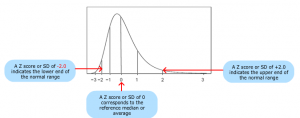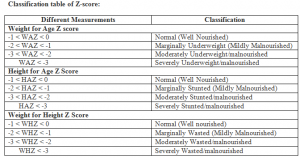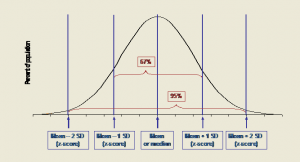
Introduction
- Z-score, also known as Standard Deviation (SD) score is the measure of dispersion/relative deviance of the data from the mean/median value i.e. measure of the distance between the child’s value and value of the reference population

Note: (Reference/sample populations are carefully selected/predetermined population which represents the entire population of a certain area of particular age and sex groups)
- It is a statistical measurement of a particular score’srelationship to the mean in a group of scores.
- To make it more clear, a z-score of 0 of an individual means that the score of an individual is same as the mean score.
- It can be both positive and negative which shows whether the particular score is greater (in case of +) or less (in case of -) than the score of sample population
- It is also necessary to know that Z-score is a comparative score not the absolute value as the score of an individual/population is compared across the reference population
- Z-score (or SD-score) = (observed value – median value of the reference population) / standard deviation value of reference population. More simply, Z- score= (Score-Mean) / SD
- Z-score can be used in different fields wherever statistical measurement is required. However, in case of nutrition we usually calculate Z-score for weight-for-height, height-for-age and weight-for-age.
- All these measurements of Z-score in nutrition give answer to the question that whether the child is malnourished or not and the range of malnutrition (mild/moderate/severe)

In other words,


Looking at Z-score value through Normally distributed Bell curve:

Advantages/usefulness of Z-score:
- Z-score can identify and pinpoint improvement or deterioration in weight and height of children in reference to the children of same age and sex
- It is statistically valid comparison to the reference population
- It can be applied to both individual and population
- Z-score is more accurate and reliable way of presenting prevalence data in population level surveys
- It is sex-independent, thus allows evaluating the growth status of children by combining sex and age groups
- The scale of Z-score is linear i.e. looking at height-for-age distribution for a 36-month-old boy; the distance from a Z-score of -2 to a Z-score of -1 is 3.8 cm. The same difference is found between a Z-score of 0 and a Z-score of +1 on the same distribution.References
http://www.who.int/nutgrowthdb/about/introduction/en/index4.html
http://www.who.int/childgrowth/training/module_c_interpreting_indicators.pdf?ua=1
http://conflict.lshtm.ac.uk/page_125.htm
http://www.indiana.edu/~educy520/sec6342/week_09/z_score_intro.pdf
http://www.ennonline.net/fex/1/practical
https://www.unicef.org/nutrition/training/3.2/8.html
https://www.unicef.org/nutrition/training/3.2/9.html
https://www.ncbi.nlm.nih.gov/pmc/articles/PMC2636355/
http://www.antrocom.net/upload/sub/antrocom/080112/13-Antrocom.pdf
http://ajcn.nutrition.org/content/46/5/749.full.pdf
http://monitoringevaluation.weebly.com/z-scores.html
http://www.quesgen.com/BMIPedsCalc.php
https://wwwn.cdc.gov/epiinfo/user-guide/Nutritional-Anthropometry/Using-the-nutrition-functions.html
https://zscore.research.chop.edu/
http://www.ellynsatterinstitute.org/fmf/fmf66.php
https://www.fantaproject.org/sites/default/files/resources/Pocket-Ref-Anthro-Feb2011-English.pdf
http://www.unhcr.org/45f6abc92.pdf
https://nutristat.codeplex.com/
Wang, Y., & Chen, H. J. (2012). Use of percentiles and z-scores in anthropometry. In Handbook of anthropometry (pp. 29-48). Springer New York.